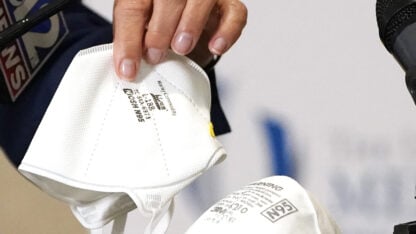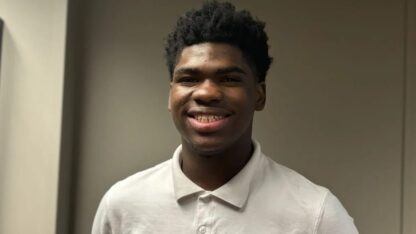Emory’s Carlos Museum Puts Shakespeare’s First Folio On Exhibit

Ali Guillory / WABE
As far as first editions go, Emory University’s Michael C. Carlos Museum has one currently on display that rivals most: it’s a copy of the first folio of the plays of William Shakespeare.
The first folio is under glass on a small podium in the center of one of the Carlos’ exhibit rooms. And with all the romanticism and mythos that the name “William Shakespeare” can conjure up, it may be a little sobering to see that it is merely a book. But this one book is responsible for an almost unfathomable portion of Western literature.
“There are about half of Shakespeare’s plays that would not now currently exist if they hadn’t been published in the first folio,” said Sheila Cavanagh, Professor of English at Emory and director of the World Shakespeare Project.
The first folio was printed in 1623, just seven years after Shakespeare’s death. It contains 36 plays, 18 of them printed for the first time, including “The Tempest,” “Twelfth Night,” “The Taming of the Shrew,” and “Anthony and Cleopatra.”
“Which is really pretty extraordinary, if you think,” said Cavanagh. “Those are some heavy-hitter plays!”
Beyond that, the folio’s very existence is kind of extraordinary.
“The idea of having folios at all was a pretty new idea,” said Rosemary Magee, Director of the Stewart A. Rose Manuscript Archives and Rare Book Library, or MARBL.
The folio was assembled just after Shakespeare’s death by John Heminges and Henry Condell, who were both actors in The King’s Men, the theatre company Shakespeare wrote for.
“Heminges and Condell, who had worked with him, knew him, wanted specifically to collect his plays and make them available in print,” Sheila Cavanagh says.
At that time, Cavanaugh explains, Shakespeare made his money for writing his plays, not publishing and selling them. The playwright Ben Jonson had just published a folio of his collected plays, and he was actually mocked for considering plays to be high art worthy of publication.
In an age when we can get basically anything into print, it’s kind of hard to imagine a time when this was a new idea that audiences had to get used to. Before the first folio, a number of Shakespeare’s individual plays were available in print, but a lot of those printings were pirated copies plagiarized from actor’s scripts or reconstructed from memory by someone who had seen the play.
Being part of Shakespeare’s company, Heminges and Condell, however, would have had access to the authentic texts.
“They saw the future, and helped create the future,” said Cavanagh.
That future went through a number of revisions and editions. The copy of the first folio on display is on loan from the Folger Shakespeare Library in Washington DC. It’s part of their celebration of the 400th anniversary of the playwright’s death.
Emory’s exhibit, however, also has the second, third, and fourth folios on display. Most are on loan from other collections, but the fourth comes from Emory’s MARBL Library. This exhibit may be the only instance in the U.S. where you can currently see the first four folios in the same place.
In addition, the university has a lot of programming this year and next, with theatrical performances, lectures and films, which ties in to the anniversary. That’s a lot of activity springing from four leather-bound volumes in a quiet museum gallery.
Of course, Shakespeare was a playwright. His works were meant to be performed and spoken aloud. So what, one might ask, can we get from these collections of his works on the page?
Here, Rosemary Magee gestures to a line of text from “The Tempest,” on the wall above the display case:
What’s past is prologue.
“It’s not just a book that’s sitting here all by itself,” Magee said. “It’s a book that is more like a tree in a way, and has far-reaching qualities.”
So for any student of the branches of western culture, Shakespeare’s folios at Emory represent some very important…and still vital seeds.
The First Folio: The Book That Gave Us Shakespeare is on display now at Emory’s Michael C. Carlos Museum through December 11.
9(MDAxODM0MDY4MDEyMTY4NDA3MzI3YjkzMw004))








